WLAN Station BLE Provisioning#
1. Purpose / Scope#
This example demonstrates how to configure/connects RS9116W EVK to get the WLAN connection functionality using BLE provisioning
RS9116W EVK starts advertising in BLE mode and Access Point details are fetched using BLE Provisioning.
RS9116W EVK is configured as a WiFi station and connects to an Access Point.
2. Prerequisites / Setup Requirements#
Before running the application, the user will need the following things to setup.
2.1 Hardware Requirements#
Windows PC with Host interface(UART/ SPI).
Silicon labs RS9116 Wi-Fi Evaluation Kit
Host MCU Eval Kit. This example has been tested with:
Silicon labs WSTK + EFR32MG21
Wireless Access point
Android Mobile Phone with Silicon labs Connect App. (or)
Windows PC with windows Silicon labs connect application.


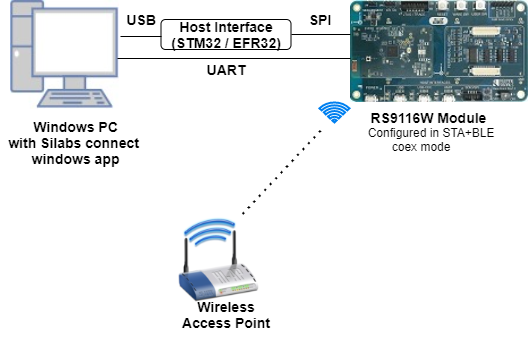

2.2 Software Requirements#
Embedded Development Environment
For STM32, use licensed Keil IDE
For Silicon Labs EFx32, use the latest version of Simplicity Studio
User can install any of the below apps to verify WLAN Station BLE Provisioning.
Install Android based Silicon labs Connect APK:
Access the apk provided in the path:
<SDK>/utilities/Silicon_lab_connectApp.apk
Install windows Silicon labs connect application in laptop.
Refer the application provided in the path:
<SDK>/utilities/windows_ble_provisioning_appFollow the instructions provided in the path:
<SDK>/utilities/windows_ble_provisioning_app/Installation_steps_to_run_silabs_connect_windows_application.docx
3. Application Build Environment#
3.1 Platform#
The Application can be built and executed on below Host platforms
3.2 Host Interface#
By default, the application is configured to use the SPI bus for interfacing between Host platforms and the RS9116W EVK.
The SAPI driver provides APIs to enable other host interfaces if SPI is not suitable for your needs.
3.3 Project Configuration#
The Application is provided with the project folder containing Keil and Simplicity Studio project files.
Keil Project:
The Keil project can be executed on STM32 platform.
Project path:
<SDK>/examples/snippets/wlan_ble/wlan_station_ble_provisioning/projects/wlan_station_ble_provisioning-nucleo-f411re.uvprojx
Simplicity Studio:
The Simplicity Studio project can be executed on EFR32MG21.
Project path:
If the Radio Board is BRD4180A or BRD4181A, then access the path
<SDK>/examples/snippets/wlan_ble/wlan_station_ble_provisioning/projects/wlan_station_ble_provisioning/projects-brd4180a-mg21.slsprojIf the Radio Board is BRD4180B or BRD4181B, then access the path
<SDK>/examples/snippets/wlan_ble/wlan_station_ble_provisioning/projects/wlan_station_ble_provisioning/projects-brd4180b-mg21.slsprojUser can find the Radio Board version as given below
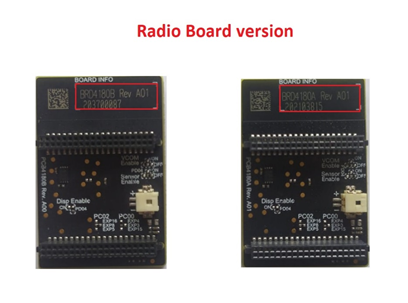

Bare Metal/RTOS Support#
The Application supports both FreeRTOS and bare metal configurations.
By default, the application project files (Keil and Simplicity Studio) are provided with RTOS enabled in the SDK, so the application can be tested/validated under OS environment.
Follow the below steps for changing the project configuration in Keil and Simplicity Studio to test the application in the bare metal environment.
Steps to configure project settings in Keil IDE
Open project in Keil IDE and click on 'Options for Target'
Go to 'C/C++' tab and remove 'RSI_WITH_OS' macro present under Preprocessor Symbols
Click on 'OK' button to save the settings


Steps to configure project settings in Simplicity Studio
Open project in Simplicity Studio
Right click on the project and choose 'Properties'
GO to 'C/C++ Build' | 'Settings' | 'GNU ARM C Compiler' | 'Symbols' and remove macro 'RSI_WITH_OS=1'
Click on 'Apply' and 'OK' to save the settings
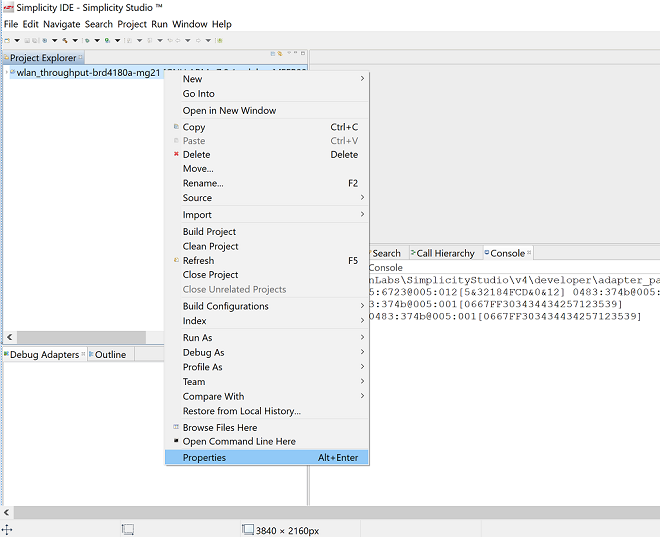

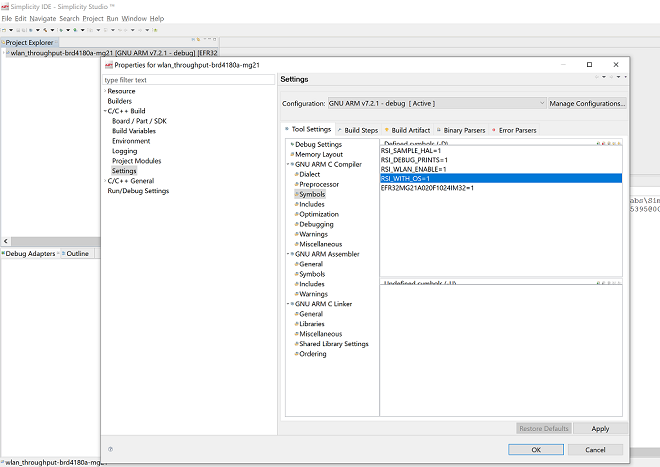

4. Application Configuration Parameters#
The application can be configured to suit your requirements and development environment. Read through the following sections and make any changes needed.
4.1 Open main.c file
Memory length for driver
#define GLOBAL_BUFF_LEN 15000The following parameters are configured if OS is used.
Task Priotrities should be given as below. Application task priority should be given as low priority and Driver task priority should be given as highest priority
#define RSI_APPLICATION_TASK_PRIORITY 1
#define RSI_BLE_TASK_PRIORITY 2
#define RSI_DRIVER_TASK_PRIORITY 3Application Task stack size is configured by this macro
#define RSI_APPLICATION_TASK_STACK_SIZE 1000BLE Task stack size is configured by this macro
#define RSI_BLW_TASK_STACK_SIZE 1000Driver Task stack size is configured by this macro
#define RSI_DRIVER_TASK_STACK_SIZE 20004.2 Open rsi_wlan_app.c file and update/modify following macro
Memory length for the send buffer
#define BUF_SIZE 16004.3 Open rsi_wlan_config.h file
#define CONCURRENT_MODE RSI_DISABLE
#define RSI_FEATURE_BIT_MAP (FEAT_SECURITY_OPEN | FEAT_AGGREGATION)
#define RSI_TCP_IP_BYPASS RSI_DISABLE
#define RSI_TCP_IP_FEATURE_BIT_MAP (TCP_IP_FEAT_DHCPV4_CLIENT | TCP_IP_TOTAL_SOCKETS_1 | TCP_IP_FEAT_EXTENSION_VALID)
#define RSI_CUSTOM_FEATURE_BIT_MAP FEAT_CUSTOM_FEAT_EXTENTION_VALID
#define RSI_EXT_CUSTOM_FEATURE_BIT_MAP 0
#define RSI_EXT_TCPIP_FEATURE_BIT_MAP EXT_DYNAMIC_COEX_MEMORY
#define RSI_BAND RSI_BAND_2P4GHZ
#define RSI_BT_FEATURE_BITMAP (BT_RF_TYPE | ENABLE_BLE_PROTOCOL)Note: rsi_wlan_config.h, rsi_bt_config.h and rsi_ble_config.h files are already set with the above desired configuration for this example.
4.4 Open rsi_ble_app.c file and update/modify following macros
RSI_BLE_CHAR_SERV_UUID refers to the attribute type of the characteristics to be added in a service.
#define RSI_BLE_CHAR_SERV_UUID 0x2803RSI_BLE_CLIENT_CHAR_UUID refers to the attribute type of the client characteristics descriptor to be added in a service.
#define RSI_BLE_CLIENT_CHAR_UUID 0x2902RSI_BLE_NEW_SERVICE_UUID refers to the attribute value of the newly created service.
#define RSI_BLE_NEW_SERVICE_UUID 0xAABBRSI_BLE_ATTRIBUTE_1_UUID refers to the attribute type of the first attribute under this service (RSI_BLE_NEW_SERVICE_UUID).
#define RSI_BLE_ATTRIBUTE_1_UUID 0x1AA1RSI_BLE_ATTRIBUTE_2_UUID refers to the attribute type of the second attribute under this service (RSI_BLE_NEW_SERVICE_UUID).
#define RSI_BLE_ATTRIBUTE_2_UUID 0x1BB1RSI_BLE_ATTRIBUTE_3_UUID refers to the attribute type of the third attribute under this service (RSI_BLE_NEW_SERVICE_UUID).
#define RSI_BLE_ATTRIBUTE_3_UUID 0x1CC1RSI_BLE_MAX_DATA_LEN refers to the Maximum length of the attribute data.
#define RSI_BLE_MAX_DATA_LEN 66RSI_BLE_APP_DEVICE_NAME refers to the name of the RS9116W EVK to appear during scanning by remote devices.
#define RSI_BLE_APP_DEVICE_NAME "BLE_CONFIGURATOR"The following are the non-configurable macros in the application.
RSI_BLE_ATT_PROPERTY_READ is used to set the READ property to an attribute value.
#define RSI_BLE_ATT_PROPERTY_READ 0x02RSI_BLE_ATT_PROPERTY_WRITE is used to set the WRITE property to an attribute value.
#define RSI_BLE_ATT_PROPERTY_WRITE 0x08RSI_BLE_ATT_PROPERTY_NOTIFY is used to set the NOTIFY property to an attribute value.
#define RSI_BLE_ATT_PROPERTY_NOTIFY 0x10BT_GLOBAL_BUFF_LEN refers to the number of bytes required by the application and the driver.
#define BT_GLOBAL_BUFF_LEN 150005. Testing the Application#
Follow the below steps for the successful execution of the application.
5.1 Loading the RS9116W Firmware#
Refer Getting started with PC to load the firmware into RS9116W EVK. The firmware binary is located in <SDK>/firmware/
5.2 Building the Application on the Host Platform#
5.2.1 Using STM32#
Refer STM32 Getting Started
Open the project
<SDK>/examples/snippets/wlan_ble/wlan_station_ble_provisioning/projects/wlan_station_ble_provisioning-nucleo-f411re.uvprojxin Keil IDE.Build and Debug the project
Check for the RESET pin:
If RESET pin is connected from STM32 to RS9116W EVK, then user need not press the RESET button on RS9116W EVK before free run.
If RESET pin is not connected from STM32 to RS9116W EVK, then user need to press the RESET button on RS9116W EVK before free run.
Free run the project
Then continue the common steps from Section 5.3
5.2.2 Using EFX32#
Refer EFx32 Getting Started
Import the project from
<SDK>/examples/snippets/wlan_ble/wlan_station_ble_provisioning/projectsSelect the appropriate .slsproj as per Radio Board type mentioned in Section 3.3
Compile and flash the project in to Host MCU
Debug the project
Check for the RESET pin:
If RESET pin is connected from STM32 to RS9116W EVK, then user need not press the RESET button on RS9116W EVK before free run
If RESET pin is not connected from STM32 to RS9116W EVK, then user need to press the RESET button on RS9116W EVK before free run
Free run the project
Then continue the common steps from Section 5.3
5.3 Steps to verify the WLAN Station BLE Provisioning Example#
5.3.1 Steps to be followed to verify WLAN Station BLE Provisioning with Android Silicon Labs Connect App#
Configure the Access point with internet connection in OPEN/WPA-PSK/WPA2-PSK mode to connect the RS9116W EVK in STA mode.
Connect any serial console for prints.
When RS9116W EVK enters BLE advertising mode, launch the Silicon Labs Connect App.


Click on BLE Provisioning.


Click on BLE_CONFIGURATOR.
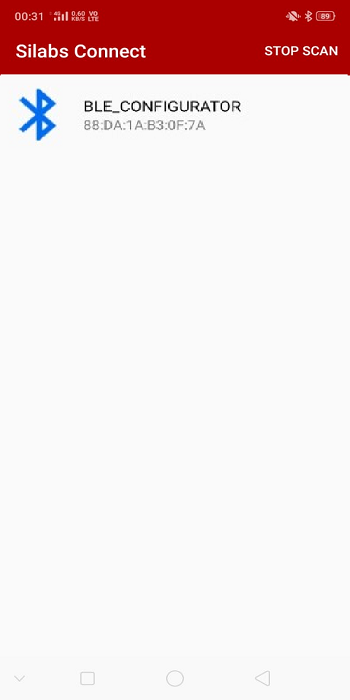

Once the BLE got the connected, list of available Access Points get displayed on the screen


Connect to an Access Point, once the RS9116W EVK gets connected to AP, IP address of RS9116W EVK get displyed on the screen


To disconnect from Access Point, click on connected AP and click on YES


Refer the below figure for console prints


5.3.2 Steps to be followed to verify WLAN Station BLE Provisioning with windows based Silicon Labs Connect App#
Configure the Access point with internet connection in OPEN/WPA-PSK/WPA2-PSK mode to connect the RS9116W EVK in STA mode.
Connect any serial console for prints.
Note: Turn on BT in the PC.
Go to folder
<SDK>/utilities/windows_ble_provisioning_appand Run Silabs_Connect.py in the command prompt.Executing the application in the command prompt as stated in the above point will open the GUI (with the “BLE SCAN ON� button.
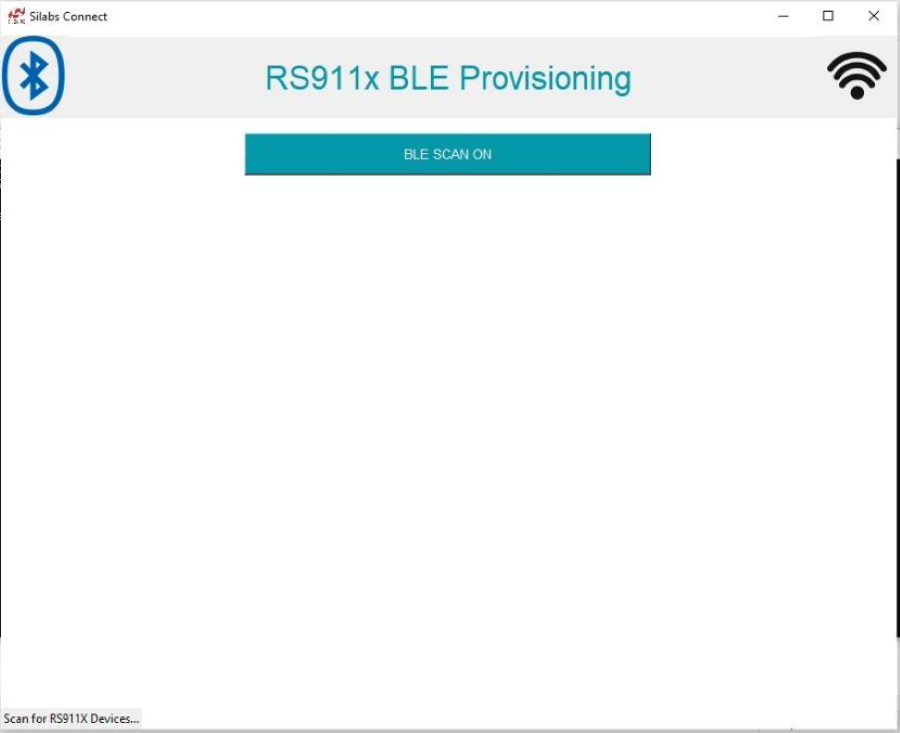

When click on the BLE SCAN ON button, all the RS9116 BLE Devices that are available nearby are displayed in the window.
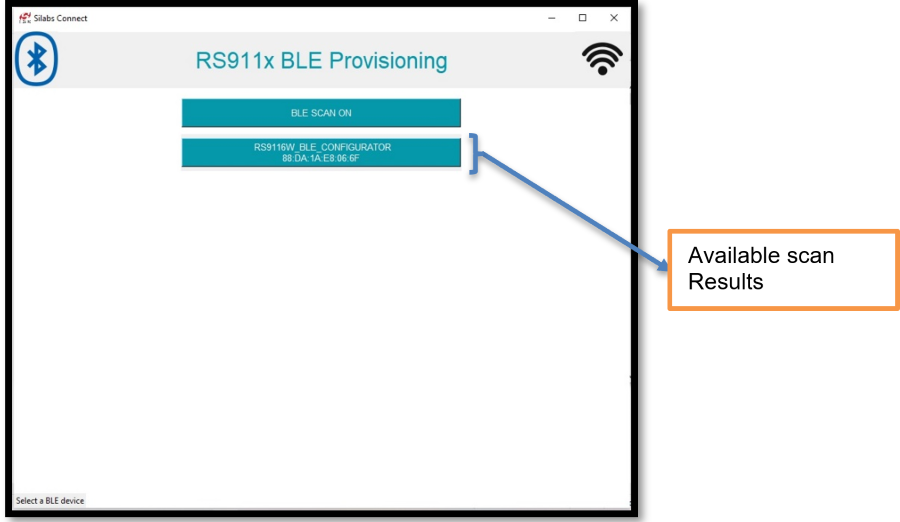

Note: - RS9116 BLE device will advertise with different names based on the application configuration.
Once RS9116 BLE device displayed on the scanning list, initiate the connection by clicking a button on the available RS9116 BLE device.


Once the BLE get connected, Firmware version and list of available Access Points get displayed on the screen.
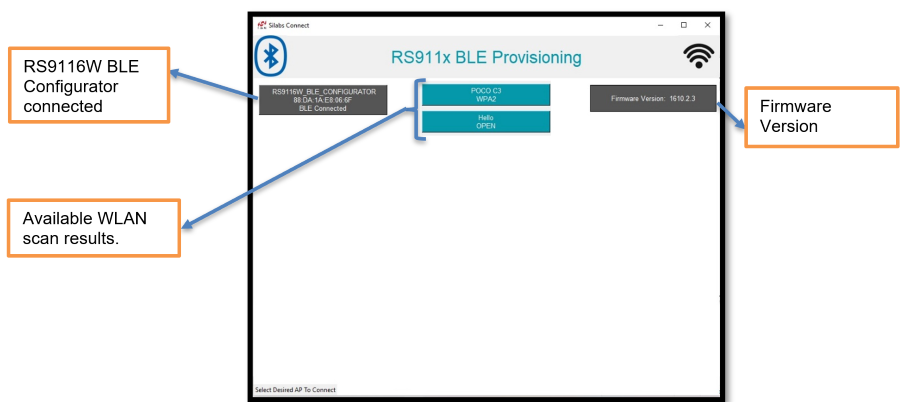

By clicking on one of the scanned AP’s, RS9116 will connect to that particular AP. If Access Point is secured it will ask the password as input but if that Access point as not secured, then directly connect to that Access Point.
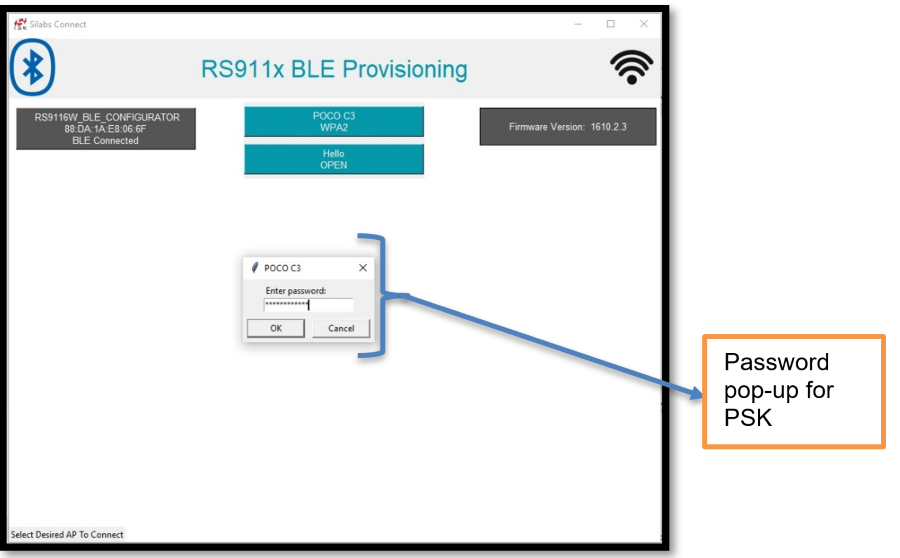

After successful connection, “IP & Mac address� of connected Access point get displayed.
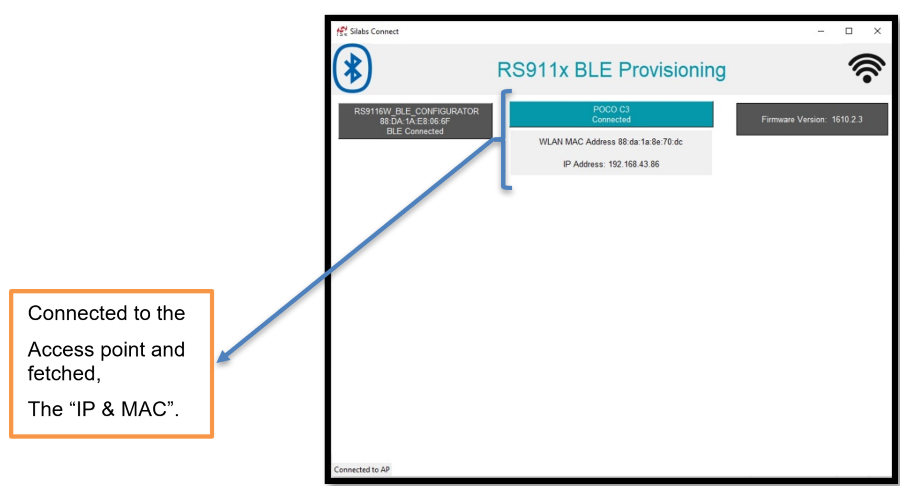

To disconnect from Access Point, click on connected AP.
After successful disconnection of WLAN, pop-up comes like WLAN GOT DISCONNECTED. Click on the “ok�.




Note: For more information refer Silabs_Connect_Windows_Application_User_Guide.pdf in the path
<SDK>/utilities/windows_ble_provisioning_app/
